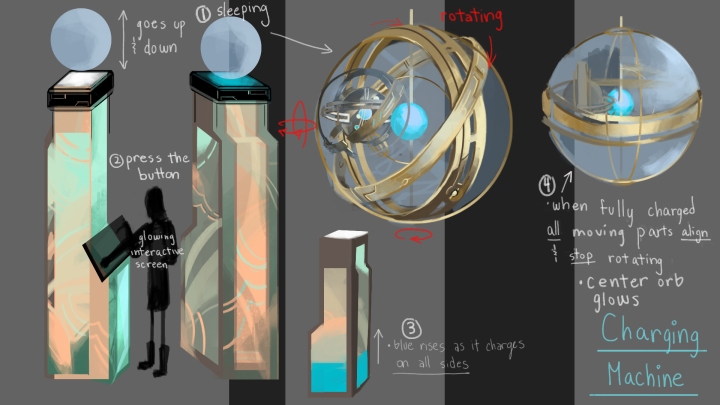
HACKER is a mobile Mafia/Assassin game that is played across a college campus. Created by Animation & Digital Arts Major Catherine Chen, the augmented reality multi-player experience is being developed on the USC campus for iOS.
Hi Catherine and team! Can you tell us a little about your project HACKER?
Hacker is a location-based AR game played on a college campus for a group of 5 – 7 friends. People of a polluted, cyberpunk society escape their reality by spending all their time in an augmented reality – a perfect world. However, a Hacker spreads a virus to cause a massive wake-up call and bring all of society out of their delusion. You and your friends are placed in the game, and have to discover the identity of the Hacker before it’s too late.
Through collaboration and using both social media apps and AR objects found on campus, the Officers have to vote together against a suspected Hacker before the Hacker eliminates all of them. At the end of every match, the in game world shifts, depending on which side wins. These visual changes persist and compound between playthroughs, creating an ever changing environment.

This strategic social game is a combination of Mafia, Spyfall, and Assassin, recreated as an augmented reality mobile game. Hacker became a finalist for AGP Green Light, and then we became greenlit as an Advanced Game Project for IMGD’s capstone class.
So far, there hasn’t been a location-based Augmented Reality social game released that is meant to be played among friends. I wanted to play this game, so I took game design classes and began producing, directing, and building this project. I had never worked in Unity before, but now we have a working prototype! We are excited to play this game, and we’re excited for others to play HACKER too.
Can you tell us more about what it was like developing the game?

We started off with a ton of artists, each specializing in specific art assets in the game.
This included USC students Haley Tomaszewski (early robot concepts), Hannah Bosnian (soda artist), Jessie Chang (temp art lead), Talia Olson (narrative lead), Izzy Rees (characters), Diego Yanez, Brenda Chen (CG modeler), Evan Wank (CG modeler), Jacque Howard (2D Animation assets), and Danielle Chua (early graphics artist). Musician Ryan Meagher also provided two excellent mood tracks.
The narrative story was developed by Talia Olson, Kaitlyn Berry, and Izzy Rees.

The game design was also constantly improving every week, as I received feedback early on from Naughty Dog game designer Richard Lemarchand, and later from SCA professors Jane Pinckard and Sean Bouchard. Other professors Danny Bilson and Scott Easley gave me feedback on the pitch as well, which helped us become AGP finalists. When I just started Hacker, animation faculty Michael Patterson (who animated the Take on Me music video) connected me to Richard, checking in on me and making sure that I had my resources and was not floating on an island alone. Additional friends helped me review and provide feedback, including many fellow USC students – even my roommates!

Because I was not an engineer, and learning how to create a map using location services, use GPS, build for Apple, using Augmented reality, and etc. was difficult, I ended up starting the engineering for the project myself. Early on, I talked to an engineer to help brainstorm for the game, but I was solely building the project until I started recruiting 6 months later, this semester. Our design lead for next year, Sydney Lang, helped with a script, and graduating senior Christopher Morales is helping me build this final month of the project, before the pitch. Heading into the final round of pitches, I am still trying to prepare a solid engineering and art team in order to pass the next round. But as long as we keep reaching out, we will hit our milestones.
The best thing about making this is that this journey has made me (and hopefully the rest of the team) better at producing content for both games and animation. As an animation student, with no previous training in game design, I am now better at communication, pitching, management, and better at animation. Because of Hacker, there are no longer any projects that I am afraid of pursuing, and I can’t wait to start another personal project again.
For any students wanting to pursue a project like this, what information would you pass along from your experience?
Being an animation major helped me enter the game development world at USC. Game students are always looking for artists, modelers, riggers, producers, engineers, and animators, so it was easy to get involved!
Work hard and use the resources outside of class. You can find what you want to do if you explore or do your own thing of class. You are never limited within your major, and don’t be afraid to collaborate with the other schools at USC, such as Thornton Music, Dramatic Arts, and even other majors at SCA.
What’s next?
We’re looking to recruit more team members as we keep building a prototype and playtesting. If you’re interested in getting involved, playtesting, or playing the completed game, you can contact me anytime or follow along on my website, http://www.crchen.com.
————
Catherine Chen (Project Lead) is an animation major at SCA who aspires to be a content creator.

